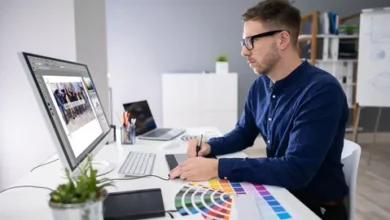Step-by-Step Checklist to Create a Poker Site Successfully
Step-by-Step Checklist to Create a Poker Site Successfully

If you’ve been thinking about setting up your own online poker platform, now’s the perfect time to do it. Online poker is booming in 2025, giving players a way to compete, socialise, and enjoy card games without leaving home. But building a poker platform is more than just launching a website — it takes strategy, planning, and the right tools to make sure everything runs smoothly.
This detailed checklist walks you through each step you need to follow to create a poker site that stands out, attracts players, and provides a seamless playing experience.
1. Define Your Goals and Target Players
The first step is getting clear about what you want to achieve with your poker site. Without a clear plan, you risk wasting time and money on features your players don’t actually want.
Ask yourself:
-
Do you want to attract casual players looking for quick games, or seasoned poker pros?
-
Will you offer only Texas Hold’em, or will you include other variations like Omaha, Seven Card Stud, or Short Deck Hold’em?
-
Will the platform be completely free-to-play, subscription-based, or include real-money games (which will require compliance with local laws)?
Once you know your goals, you can shape the entire experience — from site design and branding to feature selection and marketing strategy.
2. Choose the Right Technology Stack
The backbone of your poker site is its technology. If the software is slow, buggy, or unreliable, players won’t stay. To successfully create a poker site, focus on performance, scalability, and security.
Consider these components:
-
Frontend: React, Vue.js, or Angular provide smooth, interactive gameplay and work across all screen sizes.
-
Backend: Node.js, Python (Django/Flask), or PHP (Laravel) are common choices for game logic, matchmaking, and user management.
-
Database: MySQL, PostgreSQL, or MongoDB to store player profiles, game history, and chip balances securely.
-
Real-Time Communication: WebSockets or Socket.IO for fast table updates and in-game chat.
Fast, stable technology means players can enjoy uninterrupted games without frustrating lags or crashes — a must for competitive card play.
3. Prioritise Design and User Experience
A cluttered or confusing interface can drive players away. A clean, well-designed site helps players quickly find games, join tables, and start playing.
When designing your poker site:
-
Keep the layout simple, with easy navigation menus.
-
Optimise for both desktop and mobile users — mobile poker is growing rapidly.
-
Use clear and bold call-to-action buttons for sign-up, login, and joining tables.
-
Provide a “practice mode” or play-money tables for beginners to learn the game.
Great design isn’t just about looks — it’s about making the entire playing experience smooth and enjoyable.
4. Add the Must-Have Features
To keep players engaged, your poker site needs all the core features they expect. Here are some essentials:
-
Secure Registration and Login: Include strong password encryption, captcha, and two-factor authentication for added security.
-
Lobby System: Let players browse tables, filter by stake levels, and view upcoming tournaments.
-
Fair Gameplay: Use certified random number generators (RNG) for shuffling to ensure fairness.
-
Player Profiles: Show stats, hand history, and progress to keep users engaged.
-
Chat System: Allow players to interact socially at tables.
-
Multi-Device Support: Make sure gameplay is smooth on phones, tablets, and desktops.
-
Payment Options: If real-money play is enabled, support multiple payment methods including cards, wallets, and bank transfers.
Including these features gives players confidence in your platform and makes them more likely to return.
5. Legal and Security Compliance
If you’re planning to host real-money games, legal compliance is non-negotiable. This step is often overlooked but is one of the most important when you create a poker site.
Things to consider:
-
Licensing: Research your country or state’s gaming regulations and acquire the necessary licences.
-
Age Verification: Use systems to ensure underage players cannot sign up.
-
KYC (Know Your Customer): For real-money platforms, identity verification is required to prevent fraud.
-
Data Security: Encrypt user data, use SSL certificates, and regularly audit your security.
-
Anti-Money Laundering (AML): Implement protocols to track suspicious transactions.
Strong compliance and security build trust with your users and protect you legally.
6. Test, Test, and Test Again
Thorough testing is what separates a professional poker site from one that frustrates players.
Run multiple test games and stress-test your servers to handle traffic spikes. Look for:
-
Bugs in card dealing, betting, and pot distribution.
-
Slow loading or connection issues during peak hours.
-
Payment gateway errors or delays in withdrawals.
-
Mobile responsiveness issues on different devices and screen sizes.
A smooth, bug-free launch creates a great first impression and boosts your credibility.
7. Launch and Promote Your Poker Site
Once testing is complete and your platform is stable, it’s time to launch. Promote your new poker site on social media, online communities, and poker forums. Offer incentives like free chips or welcome bonuses to encourage players to sign up and try your platform.
Early player feedback is gold — use it to make quick improvements and fix anything you may have missed.
8. Maintain and Scale Over Time
Creating a poker site is not a one-time project — it’s an ongoing commitment. Regularly monitor server performance, release updates, and respond to player feedback.
As your user base grows, you may need to:
-
Add more tables or poker variants.
-
Introduce tournaments and leaderboard competitions.
-
Improve infrastructure to handle higher traffic.
-
Keep security measures up to date to protect against threats.
The most successful poker sites are the ones that evolve with their players.
Final Thoughts
When you create a poker site, careful planning and a player-first approach make all the difference. By following this checklist — from defining goals to scaling for growth — you’ll have a clear roadmap to building a platform that runs smoothly and keeps players coming back.
With the right mix of technology, compliance, and user experience, your poker site could become a go-to destination for players in 2025 and beyond.
—
Written by aistechnolabs, sharing practical insights to help you create a poker site that works for both you and your players.





